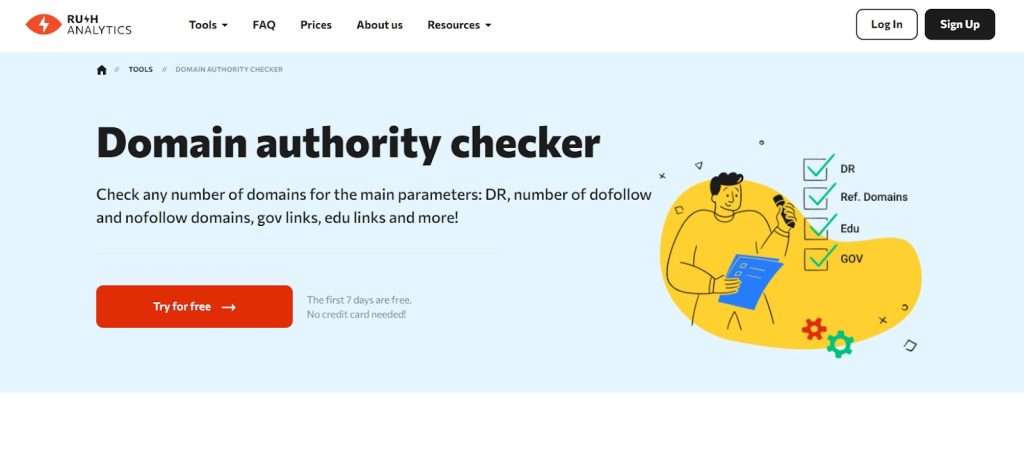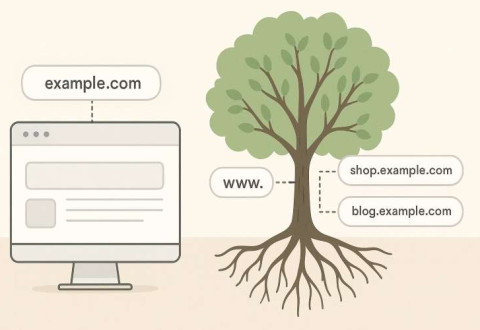A root domain serves as the fundamental building block of your website’s online presence, representing the main part of your domain name that establishes your digital identity. Think of it as the trunk of a tree – just as roots support the entire tree’s growth, a root domain supports your website’s structure and all its connected elements.
Understanding root domains is crucial for website owners and SEO professionals who want to build strong online visibility. Your root domain acts as the primary address that users type to find your website. It forms the foundation for creating subdomains, organizing content, and managing your website’s hierarchy in the domain name system.
- Root Domain Definition and Examples
- Root Domain vs. Subdomain: Key Differences
- Root Domain vs. Top-Level Domain (TLD)
- The Domain Hierarchy Explained
- How to Set Up a Root Domain
- Root Domains and SEO: Impact on Search Engine Rankings
- SEO Best Practices for Root Domains
- Using Domain Availability Checker Tools
- Conclusion: The Importance of Root Domains
- FAQs
Root Domain Definition and Examples

A root domain is the primary domain name in a website hierarchy structure that includes both the domain name and its top-level domain extension. For example, in “example.com,” the entire address represents the root domain – combining the second-level domain “example” with the top-level domain “.com.”
The root domain comes after “www” in full website addresses and encompasses all subdomains and pages connected to it. Consider these examples: “google.com” serves as Google’s root domain, while “facebook.com” represents Facebook’s root domain. These addresses represent the top level of each website’s hierarchy.
When users visit any page on your website, they’re accessing content within your root domain’s structure. This primary domain contains all website sections, from your homepage to individual blog posts and product pages.
Root Domain vs. Subdomain: Key Differences

The distinction between root domains and subdomains lies in their hierarchical relationship and organizational purpose. A root domain represents the main website, while subdomains function as separate sections branching from the primary domain.
| Aspect | Root Domain | Subdomain |
| Definition | Main website address (example.com) | Section of main website (blog.example.com) |
| Hierarchy Level | Top level of website structure | Third-level domain under root domain |
| Purpose | Represents entire website/brand | Organizes specific content sections |
| SEO Treatment | Primary domain authority | May be treated as separate site by search engines |
| Setup Requirements | Requires domain registration | Can be created under existing root domain |
| Examples | google.com, facebook.com | mail.google.com, careers.facebook.com |
Subdomains appear before the root domain and help organize website content into distinct categories. For instance, “blog.example.com” creates a dedicated space for blog content, while “shop.example.com” might house e-commerce functionality. Each subdomain can have unique content, design, and functionality while remaining connected to the main domain.
This organizational structure makes websites easier to navigate for both users and search engines. Subdomains allow businesses to create specialized sections without diluting their main domain’s focus or requiring separate domain purchases.
Root Domain vs. Top-Level Domain (TLD)
Root domains and top-level domains serve different functions within the domain name system, though they work together to create complete web addresses. A top-level domain represents the extension that follows the domain name, such as “.com,” “.org,” “.edu,” or country-code extensions like “.ca” for Canada.
| Component | Root Domain | Top-Level Domain (TLD) |
| Definition | Complete domain address | Domain extension only |
| Components | Domain name + TL | Extension (.com, .org, .net) |
| Examples | example.com, microsoft.org | .com, .org, .edu, .ca |
| Function | Full website address | Categorizes domain type/location |
| User Access | Users type this to visit site | Part of the complete address |
| Types | Combines SLD + TLD | Generic (.com) or Country-code (.uk) |
The root domain includes both the domain name and the TLD, making it the complete address users need to access your website. While “.com” is just the extension, “example.com” represents the full root domain combining both elements.
Different TLD types serve various purposes: generic TLDs like “.com” work for commercial sites, “.org” suits organizations, and country-code TLDs help target specific geographic regions. Your choice of TLD becomes part of your root domain’s identity and can influence user perception and search engine optimization.
The Domain Hierarchy Explained
The Domain Name System follows a specific hierarchical structure that starts with the root domain at the highest level. This hierarchy moves from general to specific, with each level providing more detailed location information.
At the foundation sits the zero-level domain, represented by a dot. First-level domains include TLDs like “.com” and “.org.” Second-level domains combine with TLDs to create addresses like “example.com.” Third-level domains add subdomains such as “blog.example.com.”
This numbering system helps DNS servers navigate the internet’s structure efficiently. Understanding this hierarchy helps website owners make informed decisions about domain organization and subdomain implementation for optimal site structure.
How to Set Up a Root Domain

Setting up a root domain requires several straightforward steps that establish your website’s foundation. Follow this process to get your domain operational:
- Choose your domain name – Select a memorable, brandable name that aligns with your business identity and remains easy to spell and remember.
- Check domain availability – Use domain availability tools to verify your preferred name is available across different TLD extensions.
- Purchase from a registrar – Buy your chosen domain from a reputable domain registrar, comparing prices and services offered.
- Select a hosting provider – Choose a web hosting service that meets your website’s technical requirements and traffic expectations.
- Configure DNS records – Set up Domain Name System records to point your domain to your hosting provider’s servers.
- Wait for DNS propagation – Allow 24-48 hours for DNS changes to propagate across the internet’s server network.
- Test domain functionality – Verify your domain loads correctly and all services function as expected.
Most hosting providers offer step-by-step guidance or automated setup tools to simplify this process. Once DNS propagation completes, your root domain becomes accessible to users worldwide, creating the foundation for building your online presence and establishing your digital identity.
Root Domains and SEO: Impact on Search Engine Rankings
Root domains influence search engine optimization through various indirect factors that affect website visibility and user experience. While domain names themselves aren’t direct ranking factors, several elements can impact your SEO performance and search results positioning.
Memorability plays a crucial role in user behavior and brand recognition. Short, brandable root domains prove easier for users to remember, type, and share, leading to increased direct traffic and reduced bounce rates. Search engines recognize these positive user signals as quality indicators.
Domain length affects both user experience and search engine optimization. Shorter domains generally perform better in search results because they’re more memorable and less prone to typing errors. Additionally, keyword relevance within root domains can help signal content focus to search engines, though keyword stuffing should be avoided.
Brand association strengthens over time as your root domain builds authority through quality content and user engagement. Established domains with consistent branding often achieve better search visibility than frequently changing domain names.
Boost Your Root Domain’s Authority with Rush Analytics’ Free Domain Authority Checker
Rush Analytics’ Domain Authority Checker provides essential insights into your root domain’s strength and competitive positioning. This free tool evaluates critical SEO parameters including Domain Rating (DR), quantities of dofollow and nofollow domains, and valuable government (.gov) and educational (.edu) links.

The tool analyzes your backlink profile comprehensively, revealing opportunities for improvement and identifying your domain’s authority compared to competitors. Regular monitoring helps track progress and inform link building strategies that enhance your root domain’s search engine credibility and ranking potential.
Free 7 days access to all tools. No credit card required!
Попробовать бесплатно
SEO Best Practices for Root Domains
Selecting and optimizing root domains requires strategic thinking about long-term brand goals and search engine visibility. Consider these essential practices when choosing and managing your root domain:
- Keep domains short and memorable – Choose concise names that users can easily remember, spell, and type without errors.
- Avoid keyword stuffing – Focus on brandable names rather than cramming multiple keywords unnaturally into the domain address.
- Skip hyphens and numbers – Avoid using hyphens, numbers, or special characters that can appear spammy and confuse users.
- Choose appropriate TLD extensions – Select “.com” for global reach or country-specific extensions for local businesses targeting specific regions.
- Implement SSL certificates – Ensure secure HTTPS connections for both search engine ranking benefits and user trust signals.
- Maintain brand consistency – Select domains that align with your overall brand identity and marketing strategy.
- Consider future expansion – Choose domains broad enough to accommodate business growth without limiting your scope.
- Verify trademark issues – Research potential trademark conflicts before finalizing your domain choice to avoid legal complications.
These practices help establish strong foundations for long-term SEO success and user engagement. Remember that your root domain becomes a permanent part of your brand identity, so invest time in making the right choice from the start.
Using Domain Availability Checker Tools
Domain availability checker tools streamline the process of finding available domain names and exploring alternative options when your preferred choice is taken. These tools quickly scan multiple TLD extensions and suggest variations that maintain your brand identity.
Many checkers provide additional information about existing domains, including registration dates, expiration timelines, and ownership details. This data helps identify potential acquisition opportunities when domains become available for re-registration.
Advanced availability tools also suggest alternative domain names based on your keywords, helping brainstorm creative options that maintain brand relevance while ensuring availability across multiple extensions.
Conclusion: The Importance of Root Domains
Understanding root domains provides the foundation for successful website creation and management. Your root domain establishes your online identity, influences search engine visibility, and serves as the cornerstone of your digital presence.
The knowledge gained about domain hierarchy, SEO implications, and best practices empowers website owners to make informed decisions about their online strategy. Whether launching a new website or optimizing an existing one, proper root domain management contributes significantly to long-term success.
Apply these insights to choose the right root domain, optimize its configuration, and build authority that supports your website’s growth and visibility in search engine results.
FAQs
What is an example of a root domain?
A root domain example would be “google.com” – this represents Google’s main domain including both the domain name “google” and the top-level domain “.com” without any subdomains or additional prefixes.What is the difference between a domain and a root domain?
A domain is a general term for any web address, while a root domain specifically refers to the main domain without subdomains. The root domain represents the highest level of your website hierarchy that encompasses all subdomains and pages.What is an example of a subdomain?
An example of a subdomain would be “mail.google.com” where “mail” is the subdomain that branches from the root domain “google.com” to create a separate section for email services.






